 Dear Abby, You Still Suck
|

Shannon Larratt
BME.com
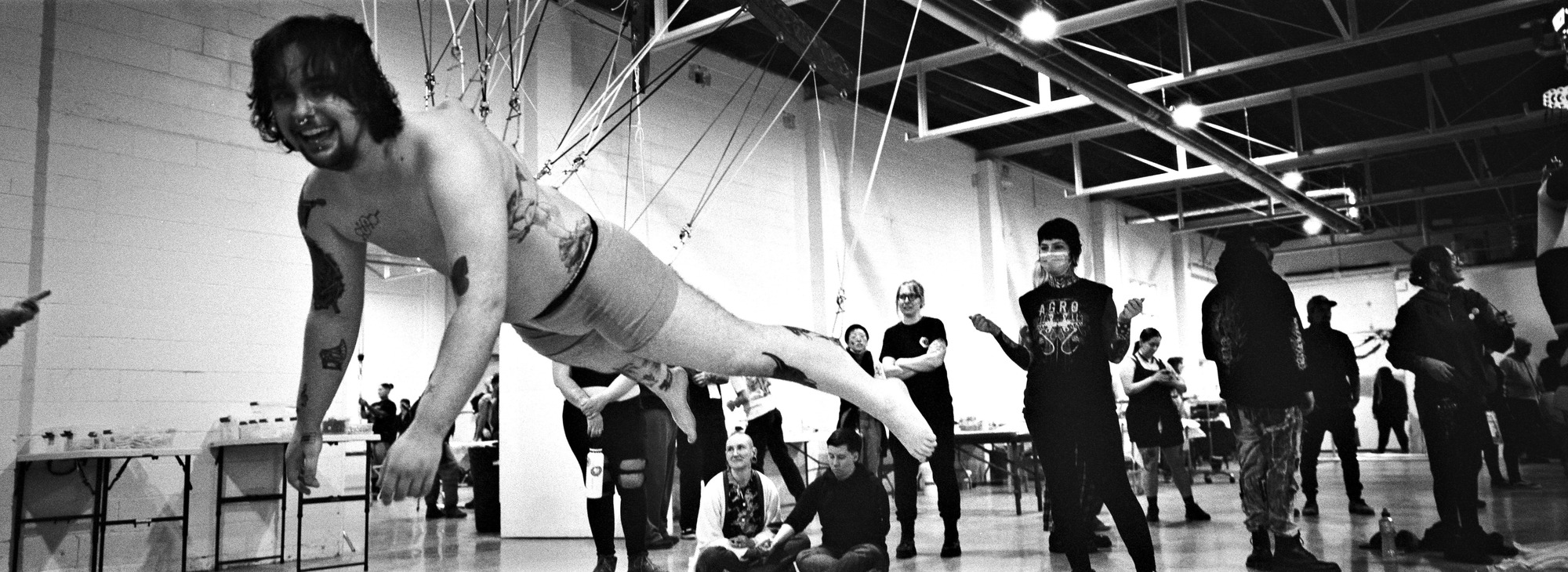
Tattoo, Piercing, and Body Modification News, Events, and Culture
Written by
 Dear Abby, You Still Suck
|

Shannon Larratt
BME.com
Written by

Pierced Eyeglasses |
“People should think things out fresh and not just accept conventional terms and the conventional way of doing things.”– R. Buckminster Fuller
|
The idea of hanging eyeglasses from a piercing or a combination of piercings or even transdermal implants is something that a lot of us have toyed with — as I was writing this, my old boss Tom Brazda reminded me that almost ten years ago we made a set of them built around a 10ga bridge piercing (with both left and right-handed threading to make it adjustable). That said, I don’t think we ever took pictures, so maybe I’m making it up because I want to steal James Sooy’s thunder. He’s who sent me this gorgeous example of a piercing-mounted set of eyeglasses:
|
|
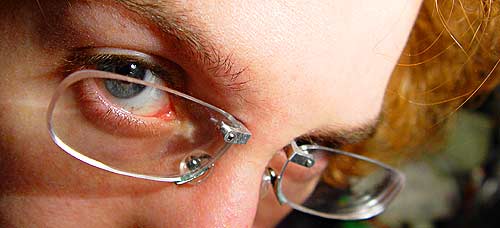
|
|
|
James is an artist currently designing and painting for Texas-based Magnificent Egos, a minatures (as in gaming) company. Art consumes all of his time, professionally and personally, and much of it is centered around character design, which gives him both time — and money — to fantasize about mods on fictional characters. With the help of his friend Oliver (who many of you know as one of the founding members and guerrilla engineers of the suspension group TSD) this fantasy was made real.
|
|
| BME: | How did you come up with the idea of attaching a pair of glasses to a piercing? |
| JAMES: | I’m not sure… some time during the drooling days of high school the idea came to me. I kept it in mind over the years and got the bridge piercing this July and then started looking to make it happen. Maybe it had something to do with not being able to wear contacts. |
| OLIVER: | I had originally considered making a pair of glasses that hung from a bridge piercing for myself about ten years ago. It was just one of those things that seemed so obvious that I was surprised I hadn’t seen it done. I never got around to doing it then, since I wasn’t too keen on getting a bridge piercing. When I got a call from James inquiring if I could help him with some jewelry he wanted to make, and then he mentioned he wanted to do the glasses as well, I jumped on the opportunity. He already had the piercing done over at Obscurities, here in Dallas, so I knew he was more serious about it than I ever was. |
| BME: | And how did you guys formalize the design? |
| JAMES: |
Oliver and I sat down for about five minutes one night to think over what would need to be done and he got straight to work making the brackets out of aluminum with a small mill in his garage!
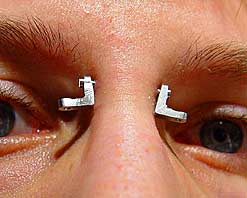 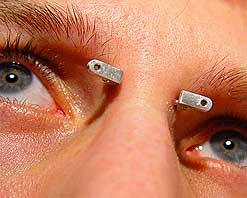 |
| OLIVER: |
Originally we were discussing and sketching ideas that would have been considerably more involved to produce. The ones that we ended up making aren’t necessarily the final product, but seemed the best and easiest way to test the viability of the idea. The brackets were machined from aluminum, roughly to shape and then drilled and tapped on my little tabletop Sherline mill — a machine that’s far more suited to this size project than what I normally use it for! After a fair bit of tweaking and polishing with files and abrasives we ended up with what you see. The part you don’t see is a barbell from Anatometal.
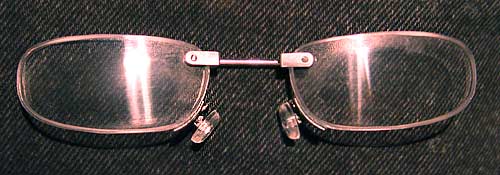 |
| JAMES: | The threading on the barbell was 1.2 mm, which happens to be a relatively uncommon and expensive thread (as far as screws go). The screws ended up delaying the project about a month. We used some lenses out of an old pair of glasses I had at first, but I decided to get some new lenses once everything else was finished. |
| BME: | What’s it like actually wearing it? What does it feel like? |
| JAMES: | They feel exactly like a regular pair of glasses, actually. I put the nose pads on to keep them from swinging around, so all the pressure is placed there, just like any other pair of glasses. Since they have no frame on the side I can wear them while I sleep and still roll onto my side. |
| BME: | Good thinking; so the piercing is more of a balance point than something structural. Does that make it more than just a “show piece”, and into something that you wear for real? |
| JAMES: | I’ve only had them for about a week now, but I’ve been sleeping and showering in them. I hadn’t taken them off in four days when one of the brackets cut me while I was asleep; I’d forgotten to sand the edges and they were still razor sharp. They’re back on now and seem reliable enough to take on a two week trip over the holidays; I doubt I’ll need to take them off during that time. Taking them on and off is a bit of a hassle, as it involves taking a tiny screwdriver and unscrewing them while they’re on my face — about a 5 to 10 minute process — which I suppose is about what you’d spend with contacts. |
| BME: | I hope they don’t get caught on anything… I suppose that could tear them out rather unpleasantly. Any thoughts on how the engineering might change for the next model? |
| OLIVER: |
This pair isn’t quite what I was looking for both in design terms and in terms of fit. I don’t think they sit at quite the right angle to his face and we both want them to sit a little closer to his eyes, so we’ll probably make another pair in the near future. Much as there are so many designs and styles of eyeglasses currently being manufactured, I think there are a number of ways this design could be improved upon. I certainly think they look neat and ended up being far more subtle than I thought they would be. I didn’t even realize he was wearing them when I saw him a few days later, and he mentioned that most people don’t notice that they are only attached to the piercing.

|
| BME: | What’s next? |
| JAMES: | I suppose I could try to make marketable version if I had ambition to do so — something easier to take on and off. As for me I only have run of the mill tattoos and piercings planned right now, but seeing how some of my friends and family are in the community and looking to push the frontier, it means I have the manpower at hand to try out what comes to mind, so I’ll keep trying out any of my feasible ideas. Being young and unsure where my future will lead, I’m quite reserved about anything permanent and visible, which limits what I’m willing to do right now… As well as not having the time or resources to work on any major projects, so it’ll just be the ones that steadily work their way in, like the glasses. |
| BME: | Since people are going to ask me, I have to ask… are these for sale? |
| JAMES: | As far as money I only spent about $10 on screws and $75 for new lenses. And I bought Oliver a meal. |
| OLIVER: |
I don’t have any intention at this point of pursuing the idea commercially but it’s not something I’m averse to doing. If others were interested I might work something out with them. I certainly wouldn’t mind seeing a more developed version of these glasses from the existing body jewelry companies. I know there are any number of people here on IAM that could probably do a much better job both in the design and execution.
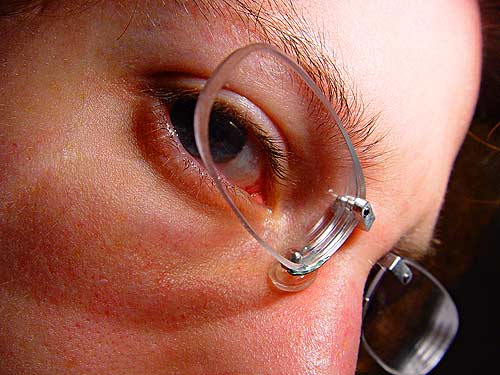 |
Be sure to visit James over at jamessooy.com, and of course you can visit Oliver at iam:antagonist. Thanks to both of them for taking the time to talk to BME, and for thinking creatively about body modification… Too few people understand that it’s OK to try something different or new.
Finally, I apologize that an article on the creative application of piercings has such an uncreative title.

Shannon Larratt
BME.com
Written by

A brief history of BME and reflections on the first ten years |
“Love knows no limit to its endurance, no end to its trust, no fading of its hope; it can outlast anything. Love still stands when all else has fallen.”– I COR 13:7-8
Ten years have passed since BME was first uploaded. In that time it has gone from being one of the first websites on the Internet to being one of the oldest and most successful, not only in body modification, but of all subjects. I have a pretty bad memory, so it’s possible that some of these things are out of order, but let me try and tell you how BME came to be what it is now.
In the summer of 1994 I was at a turning point in my life. On one hand I was building the world’s first Internet casino, was about to be featured in WIRED magazine for it, and had a flagship telephony product that was being hailed as revolutionary. On the other hand, I was fresh out of psychiatric prison, at odds with my family (it was my mother who had me drugged and locked up after I grew up to be “too weird” for her sensibilities), and had just moved back to Toronto. I was living with a stewardess at the time, which gave me a lot of unattended time to myself as I enjoyed her fancy apartment.
I’d always been “online”, but only via the BBSs I accessed using my text-only DOS-based computer. One of the systems I used had a primitive USENET gateway (newsgroups; now Google Groups) which allowed access to rec.arts.bodyart, a discussion group for all things body modification. The BBS I was using only allowed reading, not posting, so after a week or so of monitoring it in silence I set myself up with a full Internet account and “delurked”. One short week after that — August 15th, 1994 — I made the following post:
For a first issue I would like to make a sort-of-FAQ with photos (among other stuff) — something that newbies could ftp and would answer a lot of question — but I don’t want to use magazine pictures so I would need people to mail me pictures or email me scans of stuff... not just finished piercings but procedural photos if you have an unusual piece of pierce. (I will probably use photos of having an 8mm dermal punch put through my conch.)
Response was not very strong, although I did get a few photos, but I think it was luck that made the biggest difference. My ears were stretched to over an inch using homemade jewelry, but I wanted something better. In my search I happened to walk into Stainless Studios where I met Tom Brazda. He’d just hired Ryan Worden (who now runs BMEshop) to run the counter, and in September 1994 hired me to make jewelry, even though I’d never done it before, let alone even operated a lathe. Also working at Stainless Studios was Ryan O’Brien who would later run BMEbooks. In any case, with the help of their customers and portfolio (and my friend Saira’s computer, which was much better than my own), on the evening of December 7th, 1994 I was able to announce BME’s creation.
Newsgroups: rec.arts.bodyart
Date: Tues, Dec 6 1994 10:02 pm EST
Subject: Body Art Magazine / WWW SiteOk, well the magazine is much more on its way! The initial pictures from the first issue are available on my WWW site.
http://www.io.org/~glider
There are a bunch of pictures: hand web, large piercings, stretching, implant surgery, eyebrow... they are 1200dpi colour 24bit scans, all 640x480 in .jpg format — check it out. Text will be there soon too...
shannon larratt
[email protected]
It was amazing how quickly the site grew. As soon as it was up, word started to spread and people started sending in their pictures and stories as well. At this point it was nothing but a few text-only menus with links to images which could be downloaded and viewed later, but bandwidth began to spike — by December 15th it was already clear that female genital piercings drew a server-crushing amount of bandwidth!
Within a few months BME was ranked as the 25th most popular site on the fledgling Internet — of all subjects. As the Internet grew, BME normalized to about 850th of the four billion or so sites now online, but bandwidth continued to grow, cracking a million hits in the first month, and then quickly moving up to a million daily and later twenty million daily! Hosting wasn’t cheap back then, but in another “just got lucky” moment that seems to define BME, one of Internex Online’s employees turned out to be a fan of the site and helped convince her bosses that BME deserved free hosting, which they continued to provide until they were bought out by a larger telecom corporation.
That company wasn’t willing to provide me with free hosting, but they understood the business potential of the volume of readership BME was drawing. We had a series of increasingly unpleasant meetings discussing advertising, memberships, and so on. As luck would have it again, an employee of another small hosting company — Quintessential Communications (now Sound Concept) — offered me hosting under their “FreeQ” banner and with their help was able to stall becoming commercial for a few more years.
Eventually bandwidth bills caught up to Gypsy and Brian at Quintessential, and BME did take advertising, getting early support from companies like Anatometal and Unimax which was essential in keeping BME afloat. At about this time we started adding paid membership options as well, which also started to allow me to dedicate more and more time to maintaining the site and building software tools to improve it. Now that we were paying for our bandwidth usage (which was cripplingly expensive back then, and we often ran at a dramatic loss), BME bounced between ISPs a little to keep costs low, including a few more years with a new company owned by Paul Chvostek, the founder of the company who’d offered us hosting back in 1994!
BME also expanded into BME/extreme with the help of Shawn Porter who I met after the death of body modification pioneer Jack Yount — we officially launched BME/extreme on the first anniversary of Jack’s death. A little later BME/HARD was launched using all the images I’d been getting from people for the first few years that I deemed “too dirty” to use in the main sections. I’d resisted adding them because I didn’t want erotic aspects to dominate the site, but the fact is that erotic application of body modification and play is a significant sociocultural demographic, and it would be contrary to BME’s mandate of accurately representing this community to exclude it any longer. With that decision, BME had matured as a commercial entity and began to be able to stand on its own two feet.
However, BME’s financial growth brought its own problems. The first time we offered online memberships we had virtually no fraud control in place (no one did; it was too early). We were later horrified to discover that we had a fraud rate of about 75%, which instantly destroyed that billing system. I later moved on to Online Financial Systems, an early third-party adult processing competitor to companies like Ccbill (no mainstream billing service would take BME, so we had to work with people processing for pornographic sites). As much as the credit card companies “tolerate” adult sites (because they are profitable), they make life hell for them — increased rates, draconian charge-back policies, aggressive security hold-backs, and so on, and that’s if you can even find a bank willing to take on an adult customer. Most will not. Because of this BME found itself processing out of the Bahamas. The site was making enough money to pay its bills, but then the bank started getting slow on their transfers to us… and slower… “sorry, there’s a technical problem down here… you’ll get the money next month, we’re very sorry…”
After months of charges (as well as a security deposit and a rolling hold-back) had been sequestered in their tropical holding cells, it became clear they’d defrauded us and we had little to no recourse to reclaim it.
It took a few months of negotiations with new banks but eventually BME was back taking memberships — although this cycle of economic abuse would happen several more times, and I expect it to happen several more times in the future. Sometimes all it takes is the wrong person at corporate headquarters to clue in to what BME represents and we find ourselves on the street. That said, every time this has happened, BME has stayed online and continued to run, almost entirely due to generous support from those who create BME through their images and stories. It’s very important to understand that the reason that BME has worked (or at least why I think it’s worked) is because of those people. BME isn’t a magazine with a mandate of its own to push — it seeks not only to be representative of the voice of the community, but to actually be created cooperatively by the community itself.
As much as BME had tools for this community beforehand — a simple forum system, personal ads, and later even online “beauty pageants” — it’s really October 15th, 2000 that needs to be mentioned. The Net was already way into the blogging phenomenon, and I decided I’d like to have an online diary of my own. I put together a simple system for journals, and since it wasn’t really going to be much more work to do so, made it available for others to play with, posting the following message:
October 15, 2000: I am so tired! I probably shouldn’t tell you about it yet, but if you want to see what I’ve been working on, go to http://bme.com/iam/ -- Feel free to play with it if you want to, but do realize that we’re talking pre-Alpha stuff here and I’ve only completed about 25% of the programming. If you do play with it, and you experience “odd” behavior, please do tell me though.
As had happened six years before with the main BME site, IAM quickly snowballed and a vibrant community was there within the week! I added features as quickly as I could and started tying parts of the IAM site and BME together. IAM went through a set of growing pains similar to BME and now continues as (I believe) the defining online body modification community (and a pretty nice piece of software as well).
IAM has been able to provide a backbone of communication and introduction for people, and has helped catalyze tens of thousands of intense friendships, dozens of marriages (and some divorces) and now babies as well (including my own I suppose). In-person meets (echoing back to the rab munches of USENET) are common and from them suspension groups, bands, and more have sprouted. BME has grown from my little one-page website idea to a distributed empire given life by the ideas of hundreds of thousands of creators.
Maybe I’m kidding myself and the reason for BME’s success is simply pictures of female genital piercing as I opined in December 1994, but speaking without misery it’s my opinion that the reason this growth happened is because BME was always run first as a devout offering to something we all believe in, and second as a business. BME’s stated goals are as follow:
While I’ve left a lot out in this brief history — the creation of BMEshop, Uvatiarru (our movie), all the BMEbooks productions, legal fights, HUSTLER offering to buy BME, constant content theft, threats, ModCon, the Church of Body Modification, BME/Japan and much more — but that brings us basically up to date.
Reflecting on Ten Years
So… ten years of my life have been used on this project. I estimate I’ve spent at least 30,000 hours of time building and maintaining the site (and that’s my “lower limit” estimate). Was it worth it? Absolutely. As time has gone by I have become convinced of one thing:
That is, the way that we live is the right way for us to be living (I make no claim that there aren’t other paths up the mountain, but for me, and many people reading this, this is the right path for us). The things we do and the things we document on BME, almost universally, are good, in the purest sense of the word. They bring us joy, they expand and enrich our lives and horizons, they help us view the universe through larger eyes, they feel good and make us feel good about ourselves, they teach us and they help us talk — and all without hurting anyone else. Yet millions of dollars in resources are dedicated to enacting laws to ban our practices and to ban us from even talking about them, and trillion-dollar corporations do everything they can to make operating businesses on the subject hellish. My wife and I even risk prosecution and imprisonment in countries close to our hearts due to being BME’s publishers.
Why would the power players of modern society so resist the oldest form of human art and expression? It’s simple and disturbing: we are an affront to conformity, the conformity they need to maintain their power structure.
Let’s be real clear on something. The average person is an idiot. So blank and malleable in fact that the stranger telling them for a few seconds what to do — or what to buy — will be heeded. Don’t believe me? Explain advertising. The simple fact that advertising exists is all the proof you need to know that the vast majority of people are sheep. If this were not true, advertising would be based exclusively on the comparative merits of the product, which we all know is not the case. It’s one of those “can’t see the forest for the trees” scenarios — because of the abundance of ads, most of us don’t see their real message revealing the pathetic nature of most humans.
By definition, a person with piercings or tattoos — or who likes to shove a football up their rectum (damn near killed ’em!) — is breaking the rules and unable to believe that the status quo applies to them. The more they engage in body modification and play the more they realize that the status quo is a myth, that happiness really does come from within, and that life is what you make it — not what you pay someone else to make it. Thus we, the modified, are dangerous to them. It’s no lie that many of us have experimented with “risky behavior” as we are accused — because we don’t accept their rules. Because we want to know for ourselves. Because we desire to take an active role — or an active roll — in life.
I could go on and on with statistics to prove it (and have done so on my IAM page), but one of the things that has been revealed within the last four years of political turmoil is how far removed the average person’s worldview is from reality. At this point not much over 10% of Americans believe in the concept of evolution any more, and polling has showed that adherence to these views are deeply linked to political allegiance — or, to put it another way, the average person believes what they’re told to believe, not what they observe or understand to be true. Not only that, but the average person not only does not want to discover the truth for themselves, but they become openly hostile when that truth is expressed to them, and violent if it is presented alongside difficult to refute evidence.
People who “break the rules” by doing things like abnormally* modifying their physical form take a step toward rejecting this idealogical control structure. Because of this we have ridiculous and hypocritical laws restricting body modification,
or pushing it back far enough into adulthood that it is less able to be a formative experience. Those at the upper end of the power structure do not want those below them realizing the power structure is illusory — so they combine a two pronged attack of restricting growth at the edges while dumbing down and bulk-marketing that which they can’t stop. Body modification and other fringe lifestyles are treated with a mix of derision, restrictive legislation, lampoonery, and finally watered-down price-slashed mainstreaming.
Society is made up of 99% sheep, 0.9% goats, and 0.1% wolves. Before I get into that though, let me just rewind to the Janet Jackson nipple piercing fiasco and the other recent obscenity fines in America. What you may not know about these is that as much as obscenity is defined by “community standards”, only a handful of people actually find these materials obscene — in the $1.2 million dollar fine handed to FOX over Married by America, only three letters were written to the FCC complaining. Three.
![]() Maybe right now you’re asking yourself why FOX would accept the largest fine in broadcasting history for something that offended only three people out of millions of viewers (I’m quite certain that everything on TV offends at least three people). Simple answer — it was a $1.2 million campaign contribution to help convince Middle America that we — the freaks — were closing in on them. And it worked — they had a knee jerk reaction, called for “moral values”, and TV censorship is at an all time high in America, and liberties are being rolled back across the nation… including a reconsideration of whether tattooing and piercing should be legal — including even documenting it as on BME. Sometimes they do this with outright bans, but normally they do it with soft bans involving ridiculous and unfeasible health or zoning requirements. What’s happening is clear though — a tiny number of people are manipulating the group mind in order to suppress the vocal minority who aren’t connected to the enslaved and unquestioning Borg Collective paying the richest people in the world to stay rich.
Maybe right now you’re asking yourself why FOX would accept the largest fine in broadcasting history for something that offended only three people out of millions of viewers (I’m quite certain that everything on TV offends at least three people). Simple answer — it was a $1.2 million campaign contribution to help convince Middle America that we — the freaks — were closing in on them. And it worked — they had a knee jerk reaction, called for “moral values”, and TV censorship is at an all time high in America, and liberties are being rolled back across the nation… including a reconsideration of whether tattooing and piercing should be legal — including even documenting it as on BME. Sometimes they do this with outright bans, but normally they do it with soft bans involving ridiculous and unfeasible health or zoning requirements. What’s happening is clear though — a tiny number of people are manipulating the group mind in order to suppress the vocal minority who aren’t connected to the enslaved and unquestioning Borg Collective paying the richest people in the world to stay rich.
But getting back to animal land, it is the job of the goats to have fun, explore the borders, occasionally eat a tin can, and try and let the sheep know that just because “sheep” and “sheep herd” use the same spelling on their root word doesn’t mean that they’re conceptually the same thing. Sure, you’re a tribe member, but you’re also an individual. Then you’ve got the wolves, who live off the sheep. The job of the wolves is to keep the heard healthy but beat down enough to make easy victims, while killing any goat that gets too uppity.
Speaking as a lunatic who buys this metaphor, I’d like to think that BME reminds the wolves that the goats actually enjoy kicking, don’t really mind if their lip gets pierced by that risky tin can, and point out to some of the sheep that if they’d like to take on the goat role, they’re perfectly welcome to do so. I’m looking forward to ten more years of kicking wolves, and partying with risk-enamored converted sheep and all my goat friends. If a wolf kills me, which is certainly quite likely, at least I’ve died honorably… but I’d like to keep telling everyone that it’s OK to break the rules because the rules are a myth. I’d like to keep telling people that any way you want to live is fine and the more doors inside yourself you want to open the better. I want to keep broadcasting everyone’s transformative stories so they can reach as many people as possible.
Before I finish, I have one last — and most important — thing to say to everyone: Thank you for your help. I think we have done a good job together, and have expressed something wonderful. Here’s to ten (thousand) more.

Shannon Larratt
BME.com
Written by

Dealing with the Media |
“The world is for thousands a freak show; the images flicker past and vanish; the impressions remain flat and unconnected in the soul. Thus they are easily led by the opinions of others, are content to let their impressions be shuffled and rearranged and evaluated differently.”– Johann Wolfgang Von Goethe
The media loves modified people. As a rule, we are visually interesting, provocative, and often present a curiosity to their consumers that has been proven to draw ratings. Shannon recently presented a request for guests he received from the Maury Show on his page and as a result of my comments to him about it he suggested I write a column on dealing with the media. The following is a great deal of personal experience over the last decade combined with the usual dose of my opinions. I am sure there are others here on BME that can greatly add to this and I hope they will via the forums. It is important that as a community we take advantage of the media as the positive tool it can be rather than being taken advantage of by the media.
First, and most importantly, whether you are going to involve yourself with the media as a participant or just a consumer everyone should learn to look past the false glamour associated with media coverage. Appearing on TV, being interviewed on the radio, or whatever it may be is essentially meaningless. Take a look at your local paper and evening news and you will quickly see that a great deal of it is filler and that almost anyone and anything can end up there. Getting covered should not be seen as an end or achievement in itself. If you fall for this you play directly into the hands of those within the media who wish to exploit you and you very likely damage any cause you might have. Media coverage is a tool you can use but it is also a force that can easily use you.
Always remember that the media has an agenda and a plan to achieve it. This is not to say that all media outlets and people are working on nefarious schemes but rather they quite simply do have something they are out to achieve and they will do so at your expense if necessary. Interviewing you or having you on as a guest is simply a method for them to achieve their goal. If you are going to deal with the media then you must also have an agenda and a plan. If you go in unprepared then it is most likely that you will get used and end up looking dumb, or in the best-case scenario you somehow get lucky and escape with your dignity intact but nothing or little gained. At a bare minimum, because it is a business, they will attempt to do as little as possible in terms of compensating you for your contributions.
Never underestimate your importance to the media. As a guest or subject you represent the raw materials of their enterprise. Media is business. No one there is working for free and neither should you. Often, getting compensated for your time and work (and it is work) is as simple as asking. Most worthwhile productions realize that they need to pay and will do so when asked, but rarely offer up front and then lowball. The exception to this being many news programs, which don’t pay on the principle that it would impinge on their integrity. Personally, I don’t see a lot of merit in this claim for most stories but the value of advancing your agenda and getting your message out can be valuable enough to offset not getting paid. Of course, this assumes you have evaluated your ideas and goals and formulated a way to achieve them that uses the media coverage you can get.
If you are going to deal with the media you have to do your research and plan your statements before you are recorded. Even very intelligent people often end up looking silly when hit up for ‘man on the street’ comments because they are not prepared for them. You should not only refresh your knowledge of your topic and ideas but also research the particular show or outlet you will be dealing with. Try to figure out their agenda and how you can either counter it or make it work for you.

Below I have broken down some practical tips and information about various forms of media. I strongly encourage anyone who is thinking about any involvement to consult with professionals whenever possible and if you are going to be doing it with any regularity a manager or lawyer are nearly a must because there is a lot to keep track of and having people who know the business help you is invaluable.
PRINT
(newspapers, magazines, books and the like)
Print media almost never pays and is mainly suitable for advancing information or advertising yourself or your business. The exception is for photos — read releases carefully and make sure that they only allow for use in connection with the relevant story or entry and that it is only for one story or edition. This insures that any use is legitimate in terms of what you expect and that future use will result in further compensation. In terms of content I prefer to do the interviews by email so that I have a written record of what I said in an unedited form. If the interview is recorded for transcription I request a copy of the recording. Most people will supply complimentary copies of the finished product but are often lazy or forgetful about doing it.
RADIO
Much like print, radio is almost always an unpaid gig. It is best suited for information and advertising. Most radio is live, which means you have to be on your toes and well prepared. Shows may be taped and edited for later rebroadcast, which means you should take care to not present them with anything they could easily manipulate if you think they may be hostile in any way. Very rarely will there be any contracts or releases involved unless they are also recording images for a website or something similar.
TELEVISION
News: As I mentioned above, news shows rarely offer pay but they can useful in that news coverage often increases the perceived legitimacy of your statements. I won’t go into the difference between public perception and truth here, but it is worth noting that if you say something on the news it will likely go further than something spouted off on a talk show and reaches a different audience. News appearances often come with short notice and because the particular show has a story they want to run. It is very important to discern the motivation and goal of the story and to be extremely well prepared. The news rarely uses releases.
Talk Shows: Talk shows are probably the biggest offenders when it comes to claiming poverty and not paying guests. Many will try to draw people in with the promise of a free trip (hotel and airfare). This isn’t a horrible thing but the fact is that they do have a budget for guests and should at the very least be offering money for food as well. Initially, I generally tell them I want to paid AFTRA scale for the appearance. AFTRA is the American Federation of Television and Radio Actors and is similar to SAG (the Screen Actors Guild). They set minimum pay and rates for their members; this is what scale is — a minimum amount for a day’s work. You should also ask for residuals from future airings. This basically means that they agree to pay you a percentage of the original amount each time they air the episode again after the first time — with shows like Maury or Ricki Lake this can add up quickly. If they continue to balk about payment you can also suggest they pay you the day rate you would receive at your regular job since it is likely you will be missing some work to travel and appear. Sometimes they will take to this better and even news programs will sometimes go for this. In the end, don’t be afraid to stonewall — losing the appearance is not the end of the world. Check releases carefully and get help reading them through if necessary.
Domestic Cable (HBO original programs, Discovery, National Geographic, and so on): These programs have widely varying budgets but there is always money there for you — it is just a matter of how much. These shows pay to fly crews and equipment around the world, and there is no reason for you to put in the work (and these are usually the most work and disruptive to your usual life) without being compensated. This is where having an agent or manager really helps. Yes, they take a percentage but they often get you more than you would have on your own which makes up for their cut. It is very hard to get residuals from cable networks though, but worth trying — don’t let it be a deal breaker in their case.
International TV: For Americans, foreign television provides some of the most lucrative opportunities. Residuals are almost never there but the up front money is often much better. Again, an agent is very helpful. Many of these outlets pay people to find and shoot the stories and they let them keep the money in the budget that they don’t pay you. A good agent will know the current budget levels for these organizations and get you all you can.
I haven’t mentioned things like variety shows for performers or acting appearances because if you are going to do this then you really should be working with a professional to handle things. Hopefully this helps someone and don’t be afraid to ask me or anyone questions.

because the world NEEDS freaks…
Former doctoral candidate and philosophy degree holder Erik Sprague, the Lizardman (iam), is known around the world for his amazing transformation from man to lizard as well as his modern sideshow performance art. Need I say more?
Copyright © 2004 BMEzine.com LLC. Requests to republish must be confirmed in writing. For bibliographical purposes this article was first published November 27th, 2004 by BMEzine.com LLC in Toronto, Ontario, Canada.
Written by

Be Careful. You Have Enemies. |
“Trust not him that hath once broken faith; he who betrayed thee once, will betray thee again.”– Shakespeare
In this column I’d like to give you a behind-the-scenes look at some of the things body modification artists and studios have to deal with that clients may not be aware of, and that younger artists may still need a warning about. It’s very easy for us to get a false impression of the world because of the crowds of mod-friendly people who characterize BME members, but the world in general is far from so accepting a place. You all know about how this restricts our lifestyles on a surface level, but what you may not be aware of is that these sometimes prejudicial laws are also a tool for profit and business manipulation.
There are a lot of people who’d like to see the body modification industry go away or at least be under heavy regulation. Some feel this way for moralistic reasons, and others, such as those in government health agencies, are simply trying to do what they believe is in the best interests of public safety. Then there are those in competition, such as ear piercing gun manufacturers (or even just competing studios), who want piercing to be popular, but are motivated to keep financial traffic away from certain studios so they can drive as much of it as possible to their own establishments. What the industry needs to understand is that these people aren’t going to fight you by firebombing your shop — they’re going to play the system into shutting you down.

In order to play the system against you, they (whoever “they” may be) need to find a place that you come into conflict with the law. Most obviously this can involve finding (or sometimes fabricating) procedures that may not be entirely legal; tongue splitting, scarification, suspension, or other health code or criminal violation. If the assault is from outside the industry the outsiders tend to be easy to recognize at least.
Hey Shannon,Hate to bug you but this has come to my attention over the last couple of weeks through **** ***** and ***** at ***** **** Tattoos. Over the last week there have been a large number of people calling us and other shops saying they are looking to have their tongues split. What is odd is these are not heavily modded people, or even slightly "in the know" of the industry. As we all know, if you really want this done, you probably have a general idea of who to contact and/or you are at least well acquainted with your piercer because you probably would have some other work. These are so called "normal" people with no mods and they are all doing it by phone call only. We have had even one request come from an underage kid whose parent's had allegedly agreed to sign for him to have this done. These requests are flooding into our shop, through call-ins, other shops like ****, and ***** **** Tattoos, which causes me to believe that a possible investigation is happening in Ontario right now for body art practitioners that "cross the line."
We of course deny any and all knowledge/involvement and urge others to do the same. Just a heads up.
*****
In “the old days,” those doing procedures that were gray or overtly illegal operated by word of mouth, accepted new clients only when they were referred by an existing client, and certainly never advertised or talked to reporters — even photos sent to private insider publications like BME or BCQ were sent through anonymous email accounts with no names attached. When it comes to procedures like tongue splitting, practitioners should consider the wisdom of their predecessors’ discretion.
Sometimes though it’s not so easy to identify one’s enemy. Since piercing is a business, and there are now people who make their living at it, sometimes those people get carried away with fighting their competition. I’m reminded of a well known Chicago piercer, ***** ***** who conspired with the Health Board to have his competition shut down, which eventually lead to the death of a number of America’s first studios. By managing to convince the Health Board that he was their lone ally, even though he was piercing out of a tiny single room studio in the back of a clothing shop without even a separate sterilization room, he was able to dramatically increase his income and reputation — but at what cost?
Later the Health Board in the same region put a ban on suspension performances. Seeing another opportunity, this piercer attempted to “rat” on any competing shop who he felt was involved in BME BBQs or other events that might legally cross the line. It boggles my mind that someone who did “legally questionable” procedures themselves as well as suspensions would choose attempting to initiate prosecution of others for those activities as their line of attack, but ***** ***** is far from the only piercer I’ve seen try and convince the government to go after his competition, the whole time professing to be doing “the right thing”.
Others, like Canada’s **** *****, genuinely believe that instituting a conservative piercing industry is the right decision. One part civic duty, and one part — and much larger part — shameless self promotion, ***** keeps himself in the public eye with body piercing world record attempts and rabid promotion of body modification safety. An apparent career nomad, as he moves into a new region, piercing shops in the area start to feel heat due to his actions.
I work at a shop here in ***** called ********. The owner, **** *******, has been trying to get a proper body art bylaw instated here for approximately seven years. As of about a month ago, '****', or ***** ****** as I know him mostly, popped up and started trying to get the bylaw proposal thrown out with all sorts of ludicrous allegations. He wants to make scarification type mods illegal, and has been a thorn in our side since the first day we met him. We don't want to make anything illegal, and that is not what **** has been working for, for so long. We simply want to have, at the least, a minimum standard, and people checking up on the industry to make sure things are being done properly. '****' is a media hound, and will do anything, or say anything, to get himself some attention. He even went so far as to generate fictitious death threats, allegedly from our shop, in a hope that the police that showed up today would arrest my boss, so that he couldn't speak, in support, at the final council meeting tomorrow.I enjoy being able to submit photos of my mods, but with him on the site, I think that I will have to be more selective about what BME gets to see.
****** ****
Later this same piercer decided that BME was a part of the problem, and began “harvesting” the site for any photos or stories that he felt could do damage to competing businesses. He even went so far as to phone in fake complaints to the police when BME events were being held in an effort to make life unpleasant for the members of the site in return for them not helping him shut down his competition.



While regulatory and internal attacks are the most common, as I mentioned earlier, the ear piercing gun industry is another source of grief. The gun lobby has already managed to silence through threat of lawsuit many of the people who spoke out against them, but now that government health agencies are starting to regulate in response to the dangers of piercing guns, manufacturers are beginning to target piercing studios themselves. I believe this is in an effort to convince the government that studios are “even worse” than piercing guns.
Hi Shannon,
I just wanted to give you a “head’s up” about the “Ear Piercing Manufacturers *** ** **** ******” ‘s president – **** *****. You may have already heard of this jewelry salesmen / lawyer. He has harassed the APP and several other organizations related to personal services. He individually approaches health units and tries to convince them that the Ministry of Health has allowed ear piercing guns to be used on cartilage, etc. (assorted lies). He has a big surprise coming when the revised PSSP comes out.
Anyway, I just received a package from his office in **** with pictures from your site (Sprocket in Stratford, etc.) where he is actually looking for health violations and reporting them to me (piercing without gloves, etc.). I am sure that he has already forwarded his information to the Health Unit in Perth. He has managed to get himself into meetings at the Ministry of Health in Toronto, and was actually *** ** *** ****** **** **** ***** *** ******** Health Canada’s version of the PSSP.
Have a great day,
*********
The point of all this is that there are always people who can profit from your loss, so there will always be people who will use any dirty trick they can to try and cause you to lose. Above are only a very small number of the attacks I hear about weekly. Most of them come from those who seek financial gain, and others come from moralists and theocrats, but whatever the source, the preparations and defenses required are the same.
A few basic rules:
These things should be common sense. Laws are in flux, and it’s not always clear what’s permitted and what’s not, and where the lines are going to be drawn, and even with clearly defined laws, they can still be used as a tool to negatively affect the lives of others. While I certainly encourage people to share their experiences on BME, I also urge people to be prudent in selecting which ones should be shared anonymously. Remember that as much as you have friends watching you, you also have enemies watching you.

Shannon Larratt
BME.com
Written by

Fighting Back: Enforcing Tattoo Copyright |
 |
|
Robert Barnard violated the copyright of Calypso Tattoo’s Daniel DiMattia by willfully and unlawfully publishing an image of the artist’s work without permission in a commercial text that disparages the tattoo community as a whole. In exchange for not pursuing the violation in court, Barnard ceased publication of his e-book, redirected the web sites for his tattoo and body piercing e-books, paid $1,000 USD to the artist, and wrote the apology above.
This article is about not sitting back and letting people take advantage of body modification artists and enthusiasts.
It shows that we can fight back and win.
Robert Barnard is the author of the e-books “Shocking Tattoo Secrets Revealed” and “Body Piercing Revealed,” as well as other classics such as “Ferrets Revealed” and “Bipolar Exposed.” Cliché riddled, error filled, and abound with misstatements are often descriptions for self-published e-books, and “Shocking Tattoo Secrets Revealed” is no exception. An example of Barnard’s wit and wisdom on the “secretive world of tattoos” is that “occassionally” you can get AIDS from tattoo needles. Evidently, he knows something the US Center for Disease Control does not, as they have never found a case of AIDS transmitted through tattooing. He also warns women that a tattoo may look sexy on their perky young breasts — he uses the word “perky” twice in one thought — but that it won’t be sexy anymore when their boobs start to sag. I can hear the gasps of young women resonating across the Internet with this startling new information. Shocking secret, indeed.
My favorite clichés of Barnard’s are about the reasons why people get tattoos: to please a lover, to be in a gang, and to be a “freespirit.” Oh, but freespirits be warned, “what happens when you grow up a little bit and want to go to work in that law firm and they won’t hire you because of that free spirit tattoo.”
Perhaps it’s because Barnard never imagined the existence of tattooed lawyers that he flagrantly violated copyright laws by stealing images of tattoos to illustrate his text.
Perhaps it’s because he didn’t think that anyone in the modified community is smart enough to understand basic principles of law, that is, because we’re all out getting our gang symbols etched into our skin.
Perhaps it’s because he didn’t realize that one of the tattoo photos he stole might belong to a tattooist whose partner is a lawyer who wrote, “The Tattoo Copyright Controversy” discussing ways tattooists can protect themselves from the very violations Barnard committed. As one friend put, “This idiot fucked with the wrong freaks!”
Yes, he did. And Barnard finally realized it when he received my email threatening suit.
When I wrote the article for BME on copyrighting tattoos, I got a lot of flack: “The tattoo community doesn’t need lawyers treading on it” or “Let tattooists deal with design theft their own way” or “Karma not courts.” However, my article never took a position either way — I just said suing for copyright infringement was an option, take it or leave it.
A few months after the article came out, I was forced to take a position. A “tattooist” had inked a bad copy of a large portion of my custom backpiece — identically. I was pissed off, hurt, and wanted to physically ensure this guy would never tattoo again. But I chose not to sue. Or break his hands. Eventually, Karma won out and the tattooist’s shop had closed down.
I was faced with the decision once again on Monday, October 25th. While checking my email fifteen times a minute, I came across a Google Alert for the keyword tattoo with the title “Is it safe to get a tattoo?” I clicked the link and was directed to a press release for “Shocking Tattoo Secrets Revealed,” which warned that getting a tattoo can be a “life or death” decision and the best way to avoid dying would be to buy this book. Being known for my joie de vivre, I bought it.
Page one of Shocking Tattoo Secrets is a mock-up image of a real book made of paper, an aspirational jpeg for an author yearning to be on the shelves of Border’s Staff Picks. The real irony begins on page two with the author’s copyright notice asking those who did not buy the book directly from the web site to notify the author and they will be rewarded “handsomely” for outing the thief once legal action has been taken.
I scrolled through the pages wincing in pain at the banal cut-and-paste prose that anyone can find on a tattoo web site, with none of the facts and figures he actually gets right attributed to the source.
Then, after suffering through some cheesy clip-art, the images of the tattoos began, one to accompany each body part. None of the images credited the work to the artist or wearer, but many were familiar to me. In the ribs section, I saw a beautiful Japanese piece by New York artist Mike Rubendale, which I knew well. For the backpiece section (a two-sentence paragraph), I recognized the work of Seven Sins Tattoo in the UK. And for the feet … there was the work of Daniel DiMattia of Calypso Tattoo. Not only do I know Daniel’s work well, I know his shoe size, how he likes his coffee in the morning, whether he leaves the toilet seat up or down — all things couples know. But I am not only his partner, I am his lawyer and I know that he did not authorize use of that image to Barnard or anyone connected to his e-books. I also knew his client did not authorize the image.

|
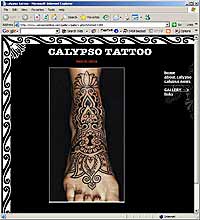
|
|
“Didn’t they outlaw torture in the Geneva convention?” |
Original work by Daniel DiMattia. |
The only other person who could have legally authorized the use of the image is Shannon Larratt who owns the copyright to images that are submitted and posted on BME where much of Daniel’s work can be found. It clearly states on the web site that under no circumstances may BME photos be republished on the Internet or offline unless permission is granted. There was also another tattoo image used in which Barnard forgot to photoshop out the BME logo. So I asked Shannon if he granted permission (never imagining he would) to Shocking Tattoo Secrets Revealed and he said no, offering to help in any lawsuit I pursued. He also pointed me to Barnard’s other site http://www.bodypiercingrevealed.com/.
 |
When deciding to pursue any kind of legal action, you have to stop and think: Is this worth it? Court cases, if not settled quickly, take up a lot of time and money and there’s hardly ever a guarantee that you’ll come out better for it. So I started digging into who is Robert Barnard. Maybe he was a fan of Calypso Tattoo and that’s why he used the image.
Unfortunately, that wasn’t the case. Out of curiosity I did a Google image search for “feet tattoo” and there on the very first page of the search results was the image of Daniel’s work. Then I did a search for “rib tattoo” and Mike’s work came up. Thigh, stomach, legs — the images used in the e-book all appear on the very first page of their respective image search. Barnard didn’t even have the drive to look further than what was immediately presented to illustrate his “work.”
For the sheer reason of his sloth, I decided I was gonna sue. If someone wants to cast aspersions on the body mod community, as many do, at least they should put a little gusto into it. It should never be that easy to undermine artists’ creations and livelihood through gross errors, stale rhetoric, and even illegally using their art against them.
So I sent this email:
| From: | Marisa Kakoulas |
| To: | Robert Barnard |
| Subject: | Shocking Tattoo Secrets -- COPYRIGHT VIOLATION |
| Date: | Oct 26, 2004 |
|
Dear Mr. Barnard, I just purchased "Shocking Tattoo Secrets Revealed" and found that you unlawfully and willfully used an image of a tattoo by my partner, Daniel DiMattia, in your e-book. I also know that you did not receive permission from the owner of the tattoo to use the image. I am an attorney and author of the article "Tattoo Copyright Controversy" I am also in contact with people whose images you have used in your book as well.I will refrain from contacting them until I have heard from you. If you wish, you may have your attorneys contact me via this email address. Thank you. Marisa Kakoulas |
Barnard replied in minutes saying he was just a hobbyist and didn’t mean any harm and that he would remove the image of the foot tattoo from the e-book.
I took time and read the book thoroughly. In the paragraph under the photo of Dan’s work was a description of getting a foot tattoo: “Didn’t they outlaw torture in the Geneva convention?” In his section on genital tattoos, Barnard says that it “makes him cringe.” Under the photo of the vivacious Isobel Varley, the most senior tattooed woman in the world, his caption of her reads, “Do you think this woman has a little too much time on her hands?” Reading the toxic tone of his writing, I didn’t buy the “didn’t mean any harm” argument, so I wrote back saying that I wanted to speak directly with his attorneys. If he wanted to settle the matter on his own, here were the terms:
I then told him that if it goes to court I may pursue a joint or class action with other artists whose copyright he violated.
Two hours later, I received a transfer of $1,000, a short apology, and the tattoo and body secrets web sites were redirected. Barnard also vowed not to publish anything tattoo related.
To Barnard’s credit, he handled things smart and quickly. I was itching to try a test case for tattoo copyright in the courts. But he explained he’s just a one-man show and has a family to feed. I told him that Daniel has a son to feed as well and that a book that fear-mongers against tattoos interferes with his ability to do so.
Barnard then thanked me for giving him the artist’s side of the story. And then asked me to leave him alone.
I’m leaving him alone. While Barnard has made money off of reviling body art, he’s not a mega-corporation with the marketing ability to affect the minds of many. He really isn’t the ideal test case.
But his story is a good example of how the modified community can fight back against those that violate our rights. I can almost guarantee he won’t mess with us again.
Marisa Kakoulas
Marisa Kakoulas is a New York lawyer, writer, and muse of Daniel DiMattia of Calypso Tattoo, living in Liege, Belgium. She works undercover — or just covered up — as a corporate consultant: proof that tattoos and suits are not mutually exclusive. Her book “Tattoo Law”, an overview of US laws affecting the body modification community, is under way. IAM members can visit Marisa at iam:FREE.Copyright © 2004 Marisa Kakoulas. Online presentation copyright © 2004 Shannon Larratt and BMEzine.com. Requests to republish must be confirmed in writing. For bibliographical purposes this article was first published online November 10th, 2004 by BMEZINE.COM in Toronto, Ontario, Canada.
Written by

BME commentary on PA House Bill No. 615 The Tattoo, Body-Piercing and Corrective Cosmetic Artists Act |
“There’s no way to rule innocent men. The only power any government has is the power to crack down on criminals. Well, when there aren’t enough criminals, one makes them. One declares so many things to be a crime that it becomes impossible to live without breaking laws.”– Ayn Rand
|
Earlier this year Tony DeLuca and others introduced several pieces of legislation to regulate piercing and tattooing in Pennsylvania. House Bill 832, which requires parental consent and presence for the tattooing and piercing of minors, passed earlier this year, albeit with a typically unrelated Senate amendment also banning greyhound racing. The second and much longer bill, House Bill 615, has passed the House and is currently in the Senate’s Health and Welfare committee.
It’s not so much that the bill is bad, but that’s it’s just typical government. In its errors and poorly considered drafting it illustrates the truth of the motto, “that government which governs best, governs least.” Like far too much modern legislation, the public would be best served if tax money was not wasted developing and enforcing this new law. The bill is ineptly written, and like most government actions, is beholden to special interests and lobbyists, as becomes clear when we begin with the definitions section.
“Body piercing.” The process of breaching the skin or mucous membrane for the purpose of insertion of any object, including, but not limited to, jewelry for cosmetic purposes. The term does not include ear piercing or nail piercing.
The disclaimer that “ear piercing” isn’t covered by this piercing bill is fairly normal due to the insidious lobbying power of the ear piercing gun industry. However, the instant we read a line that’s clearly fraudulent — can we seriously be proposing that an ear piercing is fundamentally different on a biological level than, say, a nostril ring? — we can be certain that the entirety of the bill is tainted.
The definitions section goes on to define “corrective cosmetic artist” (another group with lobbyists) as something separate from just a tattoo artist. Tattoo artists tend to get started after a year or more of apprenticeship and careful guidance from an experienced mentor. “Cosmetic” tattoo artists on the other hand are often nothing more than estheticians with a week’s training (buy now, and it’s included in the price of the equipment!) — much of the cosmetic tattoo industry is akin to artists who buy a “tattoo kit” out of the back of a lower end tattoo magazine and learn to tattoo from the included videotaped instructions. But I digress…
The bill also talks about safety regulations, registration and accounting processes, but leaves them open-ended, saying that the Department of Health will still have to define them. It is difficult to fully comment on the validity and benefits or lack thereof with a law whose heart reads “to be announced.”
But let’s not get disheartened too quickly. The bill has an interesting limitation put on it.
(f) Limitation.--Nothing in this act shall be construed to permit the department to regulate artistic aspects of tattooing, body piercing or corrective cosmetics which are unrelated to health, sanitation, sterilization or safety standards.
Sounds good, right? Unfortunately it’s a typically hypocritical statement, since we’ve already read that the bill is imposing artistic limitations by giving special status to ear piercing, exempting it from the regulations. Even if you use a spring loaded altar for bacteria to rip a hole in your lobe rather than an autoclaved needle, it’s still body piercing, and it still carries the same family of risks, if not more.
The bill goes on to list some unusual requirements and restrictions for the artists themselves — “minimum health standards”. I believe that most of these are well-intentioned, but in reality are somewhat nonsensical. Infectious diseases are taken very seriously by the bill, as they should be, but the ideas are misapplied.
(b) Infectious diseases.--A notarized statement from a licensed physician shall be provided to this department... confirming that the artist was examined by the physician, a test of the artist’s blood was made and the results of that test indicate that:(1) the artist is free from all contagious and infectious diseases, including hepatitis B;
That sounds great, I know, but it’s basically irrelevant. Under no normal circumstances is the client at risk from the piercer’s blood — the risk is entirely the other way around. Diseases like this require blood to blood contact, and while a studio that doesn’t control contamination issues could pass blood between subsequent clients, or a clumsy piercer could have a needlestick injury pass blood from client to piercer, there is no reasonable way for blood to pass from piercer to client. This bill is incompetently written by people who do not understand the issues involved. Especially in the case of government and law enforcement, comprehension must come before legislation, and that is not happening here.
The bill also requires that aftercare instructions be given. Of course I support that, but the bill steps in to make an unusual footnote.
The written instructions shall advise the customer to consult a physician at the first sign of infection and contain the name, address and phone number of the tattoo or body-piercing establishment.
Yeah, and next time I run out of gas in my car, I’m going to call a metallurgist. First of all, most of the time someone thinks their piercing is infected, it’s not. Second of all, doctors have far less experience with body piercing and tattoos than those who actually work with them every day. This clause will have two results: it will generate increased income for doctors, and I believe that, if the instructions are heeded by the client, it will result in a lower standard of care due to doctors’ inexperience with body piercing.
Some interesting social restrictions are placed as well.
(a) Unregistered practice.--It is unlawful for any person to ... assume the title of “tattooist,” “tattoo artist,” “body-piercer,” “body-piercing artist,” “corrective cosmetics artist” or other letters or titles in connection with that person’s name which in any way represents himself as being engaged in the practice of tattooing, body piercing, or corrective cosmetics, or authorized to do so, unless that person has been duly registered and authorized to engage in the practice under this act.
So, basically, the government is taking ownership over these titles as restricted professional terms (just like a normal person can’t call themselves a doctor). Outside of the fact that tattooing and piercing are arguably folk professions a la pottery or dowsing that can’t rightly be treated as “titled” professions, can we seriously expect a government agency that has already shown incompetence in its understanding of this industry to assign such titles?
...the department may suspect or revoke any registration issued under this act for any of the following reasons:
(3) Being unable to practice with reasonable skill and safety to the public by reason of illness, addiction to drugs or alcohol, having been convicted of a felonious act prohibited by... The Controlled Substance, Drug, Device and Cosmetic Act, or convicted of a felony relating to a controlled substance...
This clause again shows the sociopolitical bias inside this bill, as the US government’s misguided “War on Drugs” perverts another law. Someone having a past conviction for drug dealing seems to me less worrying than someone having committed murder in the past — this bill bans the reformed marijuana user from being a tattoo artist, yet openly invites the convicted murdering rapist pedophile to pierce teen genitals. This entire clause should be removed. It’s irrelevant to the professional issues involved and the safety of the client.
(5) Knowingly maintaining a(n)... association with any person who is in violation of this act or regulation of the department or knowingly aiding, assisting, procuring or advising any unregistered person to practice a profession contrary to this act or regulations of this department.
Guilt by association? You can’t talk to anyone who they don’t like? These are starting to read like parole restrictions. Read broadly, this clause could ban apprenticeships, ban attending tattoo conventions, and certainly ban discussions with online friends of various levels. It’s wrong to punish someone because of who they know.

Finally, there’s one restriction that goes way too far.
(d) Facial tattoos.--It is unlawful for any person other than a corrective cosmetic artist registered under this act, or a physician or surgeon licensed in this Commonwealth, to perform facial tattoo services on any other person.
Didn’t the bill start off by saying that no restrictions would be placed on the art? Only on the safety issues? Clearly restricting tattooing to only certain parts of the body is entirely motivated by cultural reasoning, not by safety concerns. The inclusion of this restriction effectively reduces the bill to nonsense. Allowing permanent makeup to be tattooed — where society chooses the artwork by seeking out this year’s “normal” — but banning art chosen by the wearer as an individual, is clearly contrary to not only the declared purpose of the bill, but to free speech and expression in general.
It’s a dangerous thing when a government deludes itself into thinking that it has the right — or duty — to decide what forms of expression its citizens use. Telling artists not only what they’re allowed to say, but also who they’re allowed to say it to, who they’re allowed to discuss their art with, and placing them under nebulous regulations has never been healthy for either art or for the culturally starved society that enacts these laws.
So what to do? While I could be wrong, I don’t believe that the authors of this bill are overtly opposed to body modification or are trying to legalize cultural bigotry. It’s simply well-meaning but incompetent and misguided bureaucracy at work, and the best we can do as citizens is first to try and inform the legislative branches of our society to not pass ill-advised laws, and to reform those that already have passed. Barring that, we are left with civil disobedience, a path which is as strewn with hardship as it is with honor.
This bill is just the tip of the iceberg. The political process does not start and end on election day. As a citizen, you have more responsibility than just voting — you have to stay informed as to what your elected representatives are doing, and you need to communicate with them about your wishes. You can bet that the ear piercing industry is doing so, and because of their efforts, the law skips over them. People have the same opportunity. You need to call or write your government representative and let them know the wishes of their constituents, and that applies to everyone in the world, not just to residents of Pennsylvania.

Shannon Larratt
BME.com
Written by

BME goes to Buenos Aires, Argentina |
“Time is the substance from which I am made. Time is a river which carries me along, but I am the river; it is a tiger that devours me, but I am the tiger; it is a fire that consumes me, but I am the fire.”– Jorge Luis Borges

I’m ashamed to say that if you’d asked me three years ago what Buenos Aires (or any South American city) looked like, I’d picture some shanty-town Caribbean city with a Hispanic population — making me a typically ignorant imperialist North American. However, through IAM I started meeting Argentinians (and others from across South America), and it soon became obvious that South America had a cultural diversity and modern society not much different than our own here in Canada. Since then, Rachel and I have wanted to visit what seemed from the outside like a wonderful place.
After several aborted attempts, we finally made plans to attend the Buenos Aires, Argentina tattoo convention hosted by Piel Magazine (pielmag.com) at the end of October 2004, organized in part by our friend la Negra (iam:la negra). The trip was almost aborted as Rachel was quite sick before we left, but she bravely faced the fifteen hour flight and we were met by Javier (also from Piel) and la Negra at the Buenos Aires international airport.
Luckily a few wrong turns on the way into the city let us see the sparse outskirts, which looked quite similar to poverty stricken regions of Canada or the United States. As we moved toward the heart of the city — the airport is about a half hour drive — it became clear that this was a truly monstrous metropolis. At ten million people, it dwarfs anything in North America except Los Angeles and New York, although it’s still far from the largest Southern city. I asked Javier how many tattoo studios I would find in the city, expecting a hundred or so. “About a thousand,” he told me, “but most are very local.”
The “modification scene” in Buenos Aires, and I imagine across most of South America, feels like it did here in Canada ten years ago. On one hand, it’s good, because it means everyone is enthusiastic and incredibly excited, but it also means that many people are operating below what is generally considered safe. While attempts have been made to set up professional organizations to encourage the use of proper contamination control and so on, only the better studios go to that effort. In part because of US financial wars with South America, Argentina has had several devastating economic periods recently as well as political turmoil, which has made many systems bribe-based. This has complicated cleaning up the tattoo industry because while an autoclave is officially required by the health board, the inspector would far rather visit for a monthly fifteen peso bribe. So they’re quite happy to turn a blind eye when a studio chooses to pay this bribe rather than go the more expensive route and upgrade their facilities.
That said, don’t get the idea that Buenos Aires is a backward or criminal city — it’s a safe, modern, multi-cultural metropolis. The food is good and the water is perfectly safe to drink. A myriad of languages are spoken (including English), Internet access is easy to find, the architecture is beautiful, the people are warm and friendly, and the heart of the downtown bears an uncanny resemblance to Toronto’s waterfront region. Temperatures are about the same as you’d find in the southern United States, and other than the truly maniacal driving style, most of what you find in Buenos Aries is incredibly close to any number of European and North American destinations.
 |
 |
 |
 |
 |
 |
 |
 |
 |
 |
 |
 |
The convention itself was hosted at the Centro Cultural Borges, an art gallery in the traditional sense of the word. Approximately fifty studios and suppliers, mostly from Buenos Aires, but with some travelling from across South America and one from Spain, filled two halls which over the weekend were attended by about ten thousand visitors. Entry cost was eight pesos — less than three dollars. Because of the devalued currency, most things cost very little in Argentina. Cab rides across town cost only a dollar or two, a large apartment can be rented for a couple hundred dollars a month, a beer costs less than a dollar, and meals cost less than half what we’d pay in Canada. Tattoos in Argentina cost about a third what they cost in North America and Europe, which is in part why only one artist from off the continent made the trip. It’s unfortunate though — I can’t imagine a much more rewarding working vacation for an artist than South America.
People at the convention were very friendly, and while many spoke almost no English, we had a note reading (in Spanish), “May we take your picture for a Canadian tattoo magazine?” Everyone was gracious and happy to help out, and a lot of people took my picture as well. The bustle of the convention was much more “happy” than any convention I’ve been to up north. I don’t know if it’s because it’s a booming culture, or just because South Americans are joy-filled, positive people in general.
Below are some of the photos that Rachel took in the studio space that Piel provided for us. I can’t thank Javier and la Negra enough — they went out of their way to make us feel welcome and provide us with anything we needed.
 |
 |
 |
 |
 |
 |
 |
 |
 |
 |
 |
 |
 |
 |
 |
 |
 |
 |
 |
 |
 |
 |
 |
 |
People almost seemed not to believe me when I told them how much I was enjoying myself both at the convention and in Buenos Aires. Maybe the grass is always greener on the other side, but to those of you in Argentina, let me be clear: there are many things about your country that I envy. Don’t assume things are better in the north — they’re just colder! Along those lines, I asked Javier what his plans were for the future of this convention, now going into its fourth year. He told me that one day he hoped it would be a world class international convention.
This surprised me — this year saw top quality artists from around the continent attending, tattoos, piercings and modifications, art fusion demonstrations, body painting, music, art galleries, contests, demonstrations, and everything you’d expect from a big international convention — including a performance by Norway’s Pain Solution. Other than not getting much media attention outside of South America, this already was a world class convention as far as I was concerned.
“When do you think that will happen,” I asked. “Maybe in year four or five?”
Javier didn’t think it would be recognized as a large international convention until maybe year fifteen. I hope he’s wrong — the only thing that keeps it from happening is jingoist North American tattoo media (BME was the only one there) and the economic issues that make it less profitable for traveling artists to attend. Maybe after reading this, and looking at the snapshots we took around the convention, studios will start to think seriously about visiting Buenos Aires and other Southern conventions instead of boring themselves with yet another American or Canadian show.
Think about it: the airline ticket is no more expensive than flying across North America. Sure, you’ll charge less for the tattoos, but your cost of staying in Argentina is half to a third what it would cost to visit a North American city convention, and you’ll gain far, far more on a personal level than you ever could staying close to home. I know I’ve already said it a couple times, but South Americans are vital, wonderful, gregarious, welcoming, happy people, and their continent — and its inhabitants — are extremely attractive.
 |
 |
 |
 |
 |
 |
 |
 |
 |
 |
 |
 |
 |
 |
 |
 |
 |
 |
 |
 |
 |
 |
 |
 |
 |
 |
 |
 |
 |
 |
 |
 |
 |
 |
 |
 |
 |
 |
 |
 |
 |
 |
As good as time as we were having, especially getting to finally meet many online friends in person for the first time, unfortunately the illness that Rachel had contracted in Toronto got progressively worse over the week, and on Saturday night, the second day of the convention, we had to fly back — as I write this she’s currently in the US receiving medical care. She as well though, even through the sickness, agrees that Buenos Aires was a wonderful city and looks forward to returning and exploring more of the country and the continent.
So our coverage includes only the first half of the convention. Sadly this means we missed Håvve’s Pain Solution performance, which I’ve been looking forward to since reading his book — I’m sure there will be more coverage on Piel’s website as well over the next few weeks. But missing it gives me an excuse to travel again!

South America is far from a cultural wasteland. There’s another Buenos Aires convention coming up at the end of November, and a convention farther south in Patagonia from the 10th to the 12th of January, 2005 (that’s the poster on the left of course). I believe it’s being organized by the artist that’s the first portrait in Rachel’s studio set above. Everyone I talked to spoke highly of this tattoo convention — “It’s wonderful; you spend all day swimming in the river, and then the convention opens at five and goes until two in the morning.”
If you don’t know what Patagonia looks like, go type it into Google Images and look at the stunning results. Knowing how much long flights stress me out, I can’t believe I’m making these plans, but I’d like to have BME down in Patagonia covering this convention. I encourage all North American (and European) artists and body modification fans to consider it as well — you won’t regret it, and it will open your eyes to another world and a parallel culture, and I think of all people, tattooed people can appreciate multiple worlds.
In closing, let me repeat what a wonderful time I had at this convention and in the country in general. Thank you to Javier and la Negra and Piel Magazine for their generosity and for throwing a great event, and thank you to all the wonderful people we met who made us feel so welcome.

Shannon Larratt
BME.com
Buenos Aires Tattoo Expo 2004 Exhibitor List: Ricky Ramirez, Lilis S.A. – Ficoinox, The Underworld – Addiction Tattoo Magazine, Bad Trip Tattoo, Micropoint, Rayo Rojo, Black Eage – Norberto Tattoo, Totas Tattoo – Negrado, Matrix Tattoo, Bola 8, Funbox, Alkimia, Joker, Shirtkam, Tattoo Museum, Tattoos by Roly, Ezequiel Nunez – Alex Tattoo, Clasic, Cover Your Bones, Nomades Tattoo – Blue Tattoos – Altstadt Tattoo, El Hombre Illustrado, Tattoos by Bara – Well Done Tattoos, Nazareno Tubaro – Esteban Felix, Dr. Qto Tattoo – R.C. Punteras, Lucho’s Tattoo, Cucaracha Tattoo – Top Cat, Tatuarg – Manitu – Acertijo Tattoo, Mr. Crowley, Corazon Salvaje, Nosferatu, Gustavo Tattoo, Tienda De Tatuajes, Delivery Tattoo Express – TattooAme.com, Tattoo Arte, Piel, PPM, Pecka Tattoo, Echysee, Ritual Eterno, CXG, Universal Tattoo, Tattoo Secrets, Suavecito Tattoo – Wicked Tattoo, Cancerbero Tattoo, Freak Models, X&X.
Written by

You just want attention, and You’re just trying to be different |
“I am convinced the only people worthy of consideration in this world are the unusual ones. For the common folks are like the leaves of a tree, and live and die unnoticed.”– The Scarecrow (L. Frank Baum)
|
In some recent columns I have addressed common questions that modified people often face from the general public. Along the same lines I thought it would be interesting to tackle potential responses to some of the more commonly made statements and assertions made to or about modified people. To get things started, here are two that I commonly hear and see, especially in online forum discussions, about myself and other visibly modified people.
“You just want attention.”
When I hear this the first thing that comes to mind is, “Yeah, so what?”
Everybody wants attention; nobody likes to be completely ignored. It is the type and source of attention desired that varies from person to person. There is nothing wrong with wanting attention. The real offense, in my mind, would be to be undeserving of attention i.e. wasting the time of people who are nice enough to give attention. Through body modification you are at least increasing the odds of there being something interesting enough about you to warrant the attention.
The next thing, and this should be apparent by the fact that someone is commenting at all, is that any effort for attention has obviously been successful. Therefore, by making this particular comment the speaker is simply congratulating the modified person on their achievement of a perceived goal. Perhaps a simple “thank you” is in order. Then again, probably not.
What really sets this comment out as an attempted insult is the qualifier ‘just’. The impolite jerk — I mean, the speaker — is trying to imply that the only reason one would modify their body is for attention. Even if this were the case, this is still a very weak and shallow attempt at an insult for the very reasons I mention above. The incredibly simple view that any behavior, especially one with as many possible cultural and personal significances as body modification, could be reduced to only one base motivation indicates immediately that you are not dealing with a member of the intellectual elite. Even trying to introduce a concept like quantum causality or merging influences would be futile unless it were an attempt to elicit the all encompassing “Huh?” so common to their ilk.
It is far better to utilize a response more suited to the audience in question. One avenue would be to point out to the person the salient points of how we all seek attention and that it is not a bad thing (unless you are terminally boring). Another, and in my experience, more fun route is to turn things around. I like to suggest that it is the impolite jerk, oops I mean speaker again, that is seeking attention and doing so very likely out of jealousy for the modified person’s ability to attract and command attention. They are only making the comment in order to draw attention to themselves in a way in which they think will win them favor for being astute or clever, something they are clearly not. Unfortunately though, they are probably preaching to an equally ignorant choir. But in the event you can’t educate them, you can at least amuse your self with their mental fumbling.
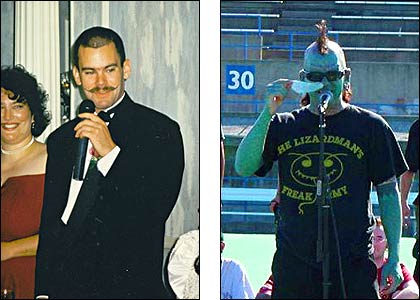
“You’re just trying to be different.”
I have often commented on how trying to be different is redundant at best since by nature we are all unique individuals. However, that ‘big picture’ view notwithstanding there are many instances in which separating one’s self out can be beneficial if not essential. This is only exacerbated by the fact that not everyone recognizes or operates in light of this fact. An environment where there is a large degree of commonality of characteristics only makes it that much easier for a person within it to lose track of their inherent uniqueness.
By purposefully decreasing the level of shared characteristics a person can help themselves to remain focused on their individuality and to develop and cultivate it. Furthermore, that person makes it far less likely they get lost in the shuffle by becoming more noticeable, for both good and ill, to others. And even ignoring this, the question remains as to what it is that is so bad about trying to be different? If we are all different then when someone implies there is something wrong with being different they must necessarily imply that there is something wrong with them as well. Toss that out and watch the confusion set in.
In theory, free thinking and going your own way are often celebrated and allegedly encouraged. However, in practice, we often see any significant variation or failure to comply with “the norm” is promptly denigrated and crushed whereas minor contextually non-threatening variations will be glorified under the guise of those alleged celebrations and encouragements.
As with the previous statement we also see the ‘just’ qualifier in play here again. And much of what I noted for “you just want attention” can also be applied here. Additionally, it can be pointed out that there are any number of methods which could equally or even more successfully garner attention and/or separate one from the crowd such as mode of dress or any number of behaviors besides body modification. And many of these would have the additional potential benefit of being far less likely to attract negative results such as these and similar statements. So, one might make the case (and I think often successfully) that the real motivation being evidenced is that of trying to be one’s own self.
If someone wants to tell me that I am just trying to be different I believe that I can more accurately show that I was already different and through my modifications I am simply trying to be myself on my own terms. But of course, I’m not surprised when at the end of my discourse I am greeted with another “Huh?”

because the world NEEDS freaks…
Former doctoral candidate and philosophy degree holder Erik Sprague, the Lizardman (iam), is known around the world for his amazing transformation from man to lizard as well as his modern sideshow performance art. Need I say more?
Copyright © 2004 BMEzine.com LLC. Requests to republish must be confirmed in writing. For bibliographical purposes this article was first published October 23rd, 2004 by BMEzine.com LLC in Toronto, Ontario, Canada.
Written by

This Article Is A Thought Crime: Why young people need body modification |
“Ninety-nine out of a hundred are automata, careful to walk in prescribed paths, careful to follow the prescribed custom. This is not an accident but the result of substantial education, which, scientifically defined, is the subsumption of the individual.”– William Torrey, US Commissioner of Education
One of the dirtiest and hardest to break urban legends in body modification is the idea that there’s some physical reason why young people can’t get piercings. The fact is though that there is no physical reason why people of all ages can’t get tattoos, piercings, scarification, or even more “extreme” modifications. Not only that, there are no valid reasons of any kind unique to minors barring them from body modifications. None. Yet nearly every area bans all or some modifications for those under the age of eighteen, and even more surprisingly, this ban is supported by the vast majority of professional piercers who rationalize it for a variety of questionable reasons.
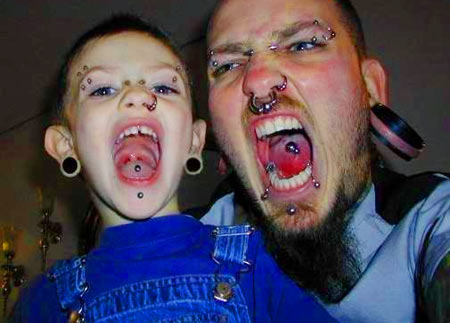
I was tattooed as a minor and I was pierced as a minor, including genital piercings. All of these things had a highly positive effect on my life, and I believe were instrumental in helping make me an independent adult capable of thinking — and doing — for myself. I’d like to now take a look at a few of the reasons presented by people opposed to piercing and otherwise modifying minors and break them down, and then propose what I believe the reason for this ban is, and why it’s fundamentally wrong.
| FALSE: Young or growing bodies can’t heal modifications. |
While an oft repeated lie, this is simply false. For most of human history people have engaged in tattooing, scarification, and piercings to mark puberty and coming of age rites, these acts taking place generally between age ten and fifteen. These modifications “survived” well into adulthood with no ill effects from either the youthfulness of the body or its subsequent growth. If anything, a young healthy person may heal modifications with more resilience and positive results than an aging individual. In any case, there is no functional or biological reason why minors can not successfully be pierced, tattooed, or otherwise modified.
| FALSE: Taking care of it is too much for a minor. |
This is fundamentally insulting, but it is a reason that’s presented very regularly. First of all, “taking care of” a piercing or tattoo is very easy and it’s well inside the grasp of even a fairly young child. It’s no more difficult than wound care in general (ever cut yourself as a kid?), and certainly far easier than tasks we expect a minor to be able to handle such as taking care of a pet, doing chores around the house, and so on.
| FALSE: It’s too big a decision for a minor to make. |
It’s somewhat difficult to pinpoint exactly when a person has experienced enough of life to be able to make major decisions, but luckily this is an issue that we’ve had to face in far more grave scenarios than — gasp — a navel piercing. We allow people to drive cars (which actually kill people when things go wrong) in their mid teens. Education decisions that will affect a person’s life far more profoundly than a little scar from a regretted piercing start getting made by people in their early teens. We allow people to marry and have children in their teens — you may disagree with this, but the law does allow it. As decisions go, the potential negative outcomes of a piercing or tattoo are dwarfed by the potential outcomes of many, many other decisions that teens are forced (and permitted) to make.
| FALSE: It’s too sexual for a minor to have. |
The fact is that minors are out there having sex. Like it or not, it’s rare for someone to “wait” until they turn eighteen or get married. Some people do, but it’s not normal, nor is it legally mandated. Pop music and youth fashion is highly sexualized (and publicly so), far more so than a navel piercing or even a genital piercing (which is private) when it comes down to it. Without a radical puritanical overhaul of Western society such an argument is hypocritical at best.
| FALSE: It’s depraved, and young people need to be protected from depravity. |
…or to put it more simply…
| FALSE: As long as you’re living under my roof, you follow my rules. |
Certainly one can make these sorts of subjective arguments about what’s appropriate behavior and what’s not, but let’s first mention that when you look at human history, body piercing and body modification is normal — our modern Western society is an odd-ball in that we don’t embrace it. In any case, while parents certainly may have some right to control or at least guide their children’s behavior, the government has no place stepping in and making the rules for them. If a parent wants to punish their child for getting an eyebrow ring, they can do so, but it’s not the State’s place to restrict the practice.
So now that we’ve seen that the presented reasons are deceptions, or at best ignorance, let’s talk about the real reason body modification for minors is illegal.
Allowing minors to engage in body modification risks them breaking the bonds of artificially extended adolescence, and helps free them from the bonds of slavery. Modern society is built around a large “slave class” of workers who are subservient to the social machine, and people are kept loyal to it through fear and blindness helped by never allowing individuals to fully move out of childhood. This makes them dependent on the State and the corporation, afraid to strike out on their own into a world that makes individuality and liberty extremely difficult to obtain.
I’ve written in the past about the education system and its goals, and this article is in part a rehash of some of those points. To simplify, the purpose of the education system is to slow down people’s ability to learn independently, making them easy to manipulate and enslave. This was done after the excellent education Americans received in the 1800s started resulting in “class jumping” where poor but well educated and bright individuals became wealthy, and those that were unfairly abused by corporations had “discontent” due to their awareness — a smart, informed person doesn’t like being a slave, they discovered, and it’s hard for rich people to stay so much richer than everyone else without slaves (or as they put it these days, indentured servants low wage employees).
The things that we learn as we graduate high school are within the intellectual grasp of the vast majority of ten year olds, given a functional education that is. I’m sure many of you reading this remember devouring books as a young child, and maybe even being told to “stop reading those books — you’re too young!” when you strayed into the science books (or whatever your interest was).
The truth of the matter is that once you hit about sixteen it’s all downhill from there as far as the way your brain (and your body) works. If you are conditioned before that point to be a slave, it’s harder and harder to break out the older you get. That’s why almost every “primitive” culture — which needed all of its members to help on the hunts, the food gathering, and so on — engaged in body modification and other “manhood” or “womanhood” or “warrior” status rituals at young ages. If people don’t define themselves as strong, independent, and competent people as youths, they will forever be constrained to relying on someone else for guidance and even food. How different is a person who’s been conditioned from birth to be dependent on their government and their employer and unable to go out on their own any different from a slave in the most traditional sense of the word?
While the piercers and parents who parrot these “rules” are largely unaware of this underlying reason, you can bet that the lawmakers are very aware of them and work incredibly hard to sustain this repressive status quo.
With that in mind, let us re-examine the above objections to modified youth.
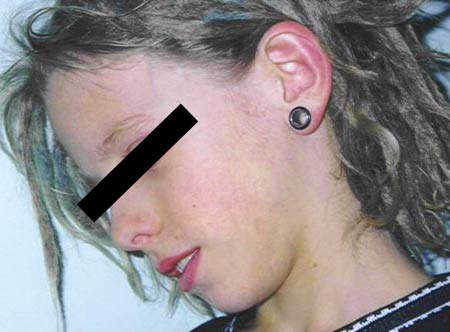
| TRUE: Young or growing bodies can heal modifications. |
Young people tend to be healthier and better able to heal modifications than aging individuals. If you’re going to do things like stretch your ears, your body is far more accepting of it the younger you are. In simple terms, the younger you are when you start stretching your ears, the better they will look when you’re done.
| TRUE: Taking care of it is easy for a minor. |
Caring for body modifications is really quite simple. Even if a minor willfully ignores the care required, the consequences are almost always extremely minor, and can teach young people in a safe fashion what will happen to them if they are not responsible for their decisions.
| TRUE: It’s an excellent way for a minor to learn decision making skills. |
Body modification is both “minor” and profound at the same time. By taking responsibility over their lives and bodies in this way, young people learn how to take care of themselves and how their decisions affect them.
| TRUE: It’s a good way for a minor to learn about their sexuality. |
Too much of a minor’s sexuality is out of their control. The media tells them how they have to behave and dress and express themselves, and massive pressure is on them to engage in sexual behavior before they are ready. This is already happening, it’s legal, and it’s very dangerous — teen pregnancy (and abortion), rape, STDs, and other problems are frighteningly common. Body modification allows a young person — or an older person — to take personal control over their sexual identities and encourages responsibility in a safe and healthy way.
| TRUE: As long as you’re living under my roof, you follow my rules. |
Well, this one might be true as stated, if the parent has limited empathy for their child that is. Children do not always have the same beliefs or interests as their parents, and ultimately, as they start to assert that personality, parents have a choice of going to war over it, or learning to love their child for who they are and making compromises so they can remain a family. Simply saying “no” without real discussion is a poor way to parent and has resulted in far too many broken homes, a tragedy that could have been averted with nothing more than an open mind.
I hope I’ve helped clarify that the end result of allowing young people to modify their bodies is not only positive, but could help catalyze much larger and extremely beneficial societal change. We can move forward to a draconian future where immense government and corporations dictate how the drones lead their lives, or we can move forward to a collaborative utopia where everyone is valuable and everyone is allowed to express themselves, working together for both common and individual goals.
I believe that this freedom is an essential notion, and that unless we imbue it in the youth, our society becomes something far darker than it even is now. Piercers, I’m not asking you to break the law — I’ve already put myself at great risk by writing this — but please don’t keep repeating the lies. Let young people and parents know just how positive body modification is for a young person. Let legislators know that it’s safe and healthy and most of all improves people’s lives.
And young people, all I can say to you is that when I — and most of the current generation of “celebrity” piercers — were your age, there were no studios and we had to pierce ourselves. At least you have the benefits of resources like BME so you’re not running blind like we were! Write about what modification does for you, good and bad, and submit it to BME or your own sites and journals. Write about it for school to help educate your teachers. Try and explain to your parents why it matters to you. Get them involved even. If body modification is good, we can prove it through our lives, right?
But please understand this: This is an uphill battle, and as “mainstream” as body modification is, it’s far from accepted. Don’t join this army unless you’re willing to fight, and fight hard. If you get modifications that the public can see, you will have to work twice as hard to get your share of jobs and education. Do everything you can to educate yourself, both at school and outside of school. Get in shape, learn every skill you can — welding, flower arranging, everything — and just make yourself an amazing individual that can do a lot of things and think intelligently on a lot of subjects. The more “powerful” and independent you are, the more you can assert yourself as an individual, and the less power anyone else has to tell you how you can live your life.
Most of all though, don’t believe their lies, and don’t accept their prison.

Shannon Larratt
BME.com
Recommended reading: “Underground History of American Education” by John Taylor Gatto. You can read it online for free here. This book will change the way you look at the Western world and its institutions. Read it before it’s banned.
PS. To the nutcases who are calling the FBI because of the photo at the start of this article, of course it’s a fake photo. We don’t live in a perfect world, yet.